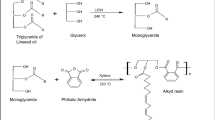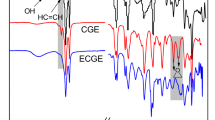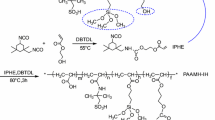Abstract
A novel UV-curable hyperbranched polyester-urethane-acrylate (PUA) resin was successfully synthesized using citric acid as a core bio-based material and ester-urethane-acrylate linkage as the arm and was applied on both wood and metal substrates. Citric acid was employed as a functionality-enhancing bio-based monomer for coating applications. This resin (PUA) was synthesized from citric acid (CA)-based polyester-polyol (CAP) and subsequently reacted with isophorone diisocyanate (IPDI) and end-capped with 2-hydroxyethylmethacrylate (HEMA) to form a tetra-functional acrylate precursor (UCAP). Fourier-transform infrared spectroscopy (FTIR), proton nuclear magnetic resonance spectroscopy (1H-NMR) and gel permeation chromatography (GPC) were used to characterize the citric acid-based polyester-urethane-acrylate (UCAP). This oligomer was formulated with a reactive diluent and a photoinitiator (UCAP PUA), applied on both wood and metal substrates and cured under UV-radiation. The mechanical, chemical and thermal properties of the coated substrates were investigated and compared to a commercial urethane acrylate (CUA). The mechanical properties such as crosscut adhesion, pencil hardness, impact strength and flexibility showed comparable results. Even though the chemical resistance and free film properties of the synthesized urethane acrylate (UCAP) were found to be inferior, the thermal properties were observed to be superior.
Graphical abstract








Similar content being viewed by others
References
Nkeuwa, WN, Riedl, B, Landry, V, “Transparent UV-Cured Clay/UV-Based Nanocomposite Coatings on Wood Substrates: Surface Roughness and Effect of Relative Humidity on Optical Properties.” J. Coat. Technol. Res., 14 555–569 (2017)
Schwalm, R, "The UV Curing Process." In: UV Coatings, Basics, Recent Developments and New Applications, pp. 19–61. Elsevier (2007)
Fu, J, et al. “Research Progress of UV-Curable Polyurethane Acrylate-Based Hardening Coatings.” Prog. Org. Coat., 131 82–99 (2019)
Mirshahi, F, Bastani, S, Ganjaee Sari, M, “Studying the Effect of Hyperbranched Polymer Modification on the Kinetics of Curing Reactions and Physical/Mechanical Properties of UV-Curable Coatings.” Prog. Org. Coat., 90 187–199 (2016)
Xiang, H et al., "Preparation, Characterization and Application of UV-Curable Flexible Hyperbranched Polyurethane Acrylate." Polymers, 9 (2017)
Choi, WC, Lee, WK, Ha, CS, “Synthesis and Properties of UV-Curable Polyurethane Acrylates Based on Different Polyols for Coating of Metal Sheets.” Mol. Cryst. Liq. Cryst., 660 104–109 (2018)
Dias, BS, Navalho, JEP, Pereira, JCF, "Multi-Scale Modeling And Simulation of IR Radiative Drying for Coil Coating Processes." Dry. Technol., 0 1–17 (2022)
Ribas-Massonis, A, Cicujano, M, Duran, J, Besalú, E, Poater, A, “Free-Radical Photopolymerization for Curing Products for Refinish Coatings Market.” Polymers, 14 2856 (2022)
Holechek, JL, Geli, HME, Sawalhah, MN, Valdez, R, "A Global Assessment: Can Renewable Energy Replace Fossil Fuels By 2050?" Sustainability (Switzerland), 14 (2022)
Dixit, A, Wazarkar, K, Sabnis, AS, “Antimicrobial UV Curable Wood Coatings Based on Citric Acid.” Pigment Resin Technol., 50 533–544 (2021)
Geeti, DK, Niranjan, K, “Environmentally Benign Bio-Based Waterborne Polyesters: Synthesis, Thermal- and Bio-Degradation Studies.” Prog. Org. Coat., 127 419–428 (2019)
Djordjevic, I, Choudhury, NR, Dutta, NK, Kumar, S, “Synthesis and Characterization of Novel Citric Acid-Based Polyester Elastomers.” Polymer, 50 1682–1691 (2009)
Hazarika, D, Karak, N, “Waterborne Sustainable Tough Hyperbranched Aliphatic Polyester Thermosets.” ACS Sustain. Chem. Eng., 3 2458–2568 (2015)
Lang, K, Sánchez-Leija, RJ, Gross, RA, Linhardt, RJ, “Review on the Impact of Polyols on the Properties of Bio-Based Polyesters.” Polymers, 12 1–25 (2020)
Mani, G, Kyobum, K, Sengottuvelan, B, “Water Soluble Self-Aggregates Induced Green Emission of Biocompatible Citric Acid-PEG Hyper Branched Polymer.” Sci. Rep., 7 1–7 (2017)
Chandra, S, Karak, N, “Environmentally Friendly Polyurethane Dispersion Derived from Dimer Acid and Citric Acid.” ACS Sustain. Chem. Eng., 6 16412–16423 (2018)
Tai, NL, Adhikari, R, Shanks, R, Adhikari, B, “Starch-Polyurethane Films Synthesized Using Polyethylene Glycol-Isocyanate (PEG-Iso): Effects of Molecular Weight, Crystallinity, and Composition of PEG-Iso on Physiochemical Characteristics And Hydrophobicity of the Films.” Food Packag. Shelf Life, 14 116–127 (2017)
Hu, Y, et al. “Bio-Based Reactive Diluent Derived from Cardanol and its Application in Polyurethane Acrylate (PUA) Coatings with High Performance.” J. Coat. Technol. Res., 16 499–509 (2019)
Teo, KT, Hassan, A, Gan, SN, "UV-Curable Urethane Acrylate Resin from Palm Fatty Acid Distillate." Polymers, 10 (2018)
Sharmin, E, Zafar, F, Akram, D, Alam, M, Ahmad, S, “Recent Advances in Vegetable Oils Based Environment Friendly Coatings: A Review.” Ind. Crops Prod., 76 215–229 (2015)
Zhang, K, et al. “Effect of Hyperbranched Poly(Citric Polyethylene Glycol) with Various Polyethylene Glycol Chain Lengths on Starch Plasticization and Retrogradation.” Polym. Int., 69 274–279 (2020)
Lin, SB, et al. “Properties of UV-Cured Polyurethane Acrylates: Effect of Polyol Type and Molecular Weight.” Chem. Eng. Commun., 30 251–273 (1984)
Wei, D, Liao, B, Huang, J, Zhang, M, Pang, H, “Fabrication of Castor Oil-Based Hyperbranched Urethane Acrylate UV-Curable Coatings via Thiol-Ene Click Reactions.” Prog. Org. Coat., 135 114–122 (2019)
Fang, C, Li, N, Liu, Y, Lu, G, "Toughening Epoxy Acrylate with Polyurethane Acrylates and Hyper-Branched Polyester in Three Dimensional Printing." Mater. Res. Express., 5 (2018)
Sengupta, S, Das, T, Bandyopadhyay, A, "Structure–Property Relationship of Hyperbranched Polymers." In: Hyperbranched Polymers for Biomedical Applications, pp. 109–134. Springer, Singapore (2018)
Sun, Z, Fan, H, Chen, Y, Huang, J, “Synthesis of Self-Matting Waterborne Polyurethane Coatings with Excellent Transmittance.” Polym. Int., 67 78–84 (2018)
Gursel, A, "Adhesion Mechanism and Failure Modes in Adhesively Bonded Joints." In: International Conference on Material Science and Technology in Kızılcahamam/ANKARA (IMSTEC), pp. 108–114 (2019)
Szycher, M, Szycher's Handbook of Polyurethanes (2nd ed.), Taylor & Francis Group, London, New York (2013)
Das, A, Mahanwar, P, “A Brief Discussion on Advances in Polyurethane Applications.” Adv. Ind. Eng. Polym. Res., 3 93–101 (2020)
Bánsági, T, Taylor, AF, “Ester Hydrolysis: Conditions for Acid Autocatalysis and a Kinetic Switch.” Tetrahedron, 73 5018–5022 (2017)
Sajid, MA, "Hydrolysis of Esters: Mechanism and Conditions." pp. 1–15. Psiberg (2021)
Chen, T, Zhang, W, Zhang, J, “Alkali Resistance of Poly(Ethylene Terephthalate) (PET) and Poly(Ethylene Glycol-Co-1,4-Cyclohexanedimethanol Terephthalate) (PETG) Copolyesters: The Role of Composition.” Polym. Degrad. Stab., 120 232–243 (2015)
Kotanen, S et al., "Hydrolytic Stability of Polyurethane/Polyhydroxyurethane Hybrid Adhesives." Int. J. Adhes. Adhes. 110 (2021)
Pandit, SK, Tudu, BK, Mishra, IM, Kumar, A, “Development of Stain Resistant, Superhydrophobic and Self-Cleaning Coating on Wood Surface.” Prog. Org. Coat., 139 105453 (2020)
Wu, YH, Wang, CC, Chen, CY, “Effect of the Cyclic Structure Content on Aliphatic Polycarbonate-Based Polyurethane.” Polym. J., 53 695–702 (2021)
Yang, Z, Peng, H, Wang, W, Liu, T, “Crystallization Behavior of Poly(ε-Caprolactone)/Layered Double Hydroxide Nanocomposites.” J. Appl. Polym. Sci., 116 2658–2667 (2010)
Acknowledgments
The authors would like to thank Pidilite Industries Ltd, Mumbai, for providing poly(ethylene glycol) – 200 (PEG-200) and hydroxyethylmethacrylate (HEMA) and for DSC analysis of UV-cured films and Allnex Resins India Pvt. Ltd., Mumbai, for providing commercial urethane tetracrylate (Ebecryl 8405).
Author information
Authors and Affiliations
Corresponding author
Ethics declarations
Conflict of interest
The authors declare no conflict of interest to declare.
Additional information
Publisher's Note
Springer Nature remains neutral with regard to jurisdictional claims in published maps and institutional affiliations.
This paper was presented at the Surfaces, Interfaces and Coatings Technology International Conference that was held virtually from April 7–9, 2021.
Rights and permissions
Springer Nature or its licensor (e.g. a society or other partner) holds exclusive rights to this article under a publishing agreement with the author(s) or other rightsholder(s); author self-archiving of the accepted manuscript version of this article is solely governed by the terms of such publishing agreement and applicable law.
About this article
Cite this article
Maity, D., Tade, R. & Sabnis, A.S. Development of bio-based polyester-urethane-acrylate (PUA) from citric acid for UV-curable coatings. J Coat Technol Res 20, 1083–1097 (2023). https://doi.org/10.1007/s11998-022-00728-5
Received:
Revised:
Accepted:
Published:
Issue Date:
DOI: https://doi.org/10.1007/s11998-022-00728-5




